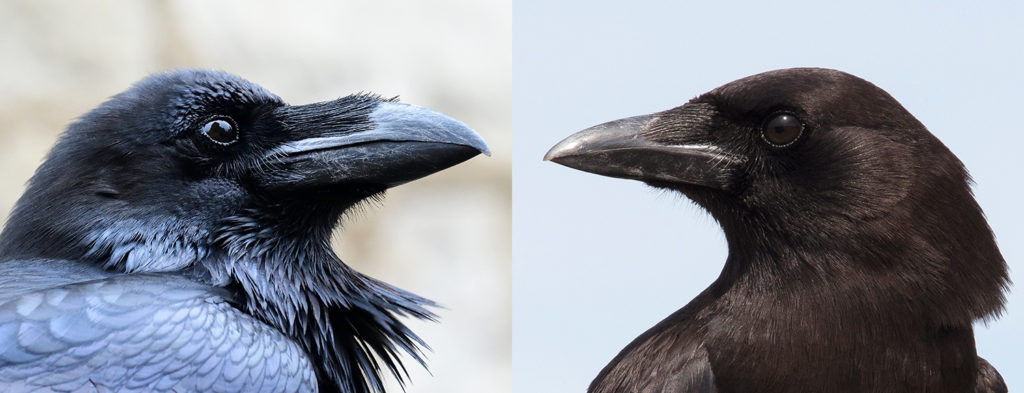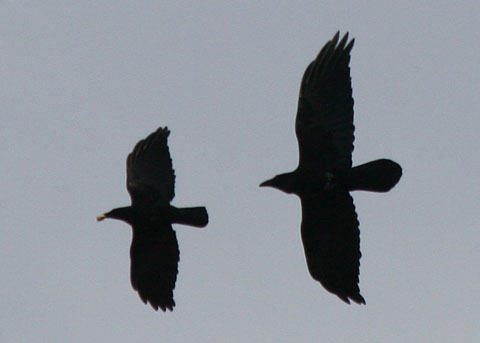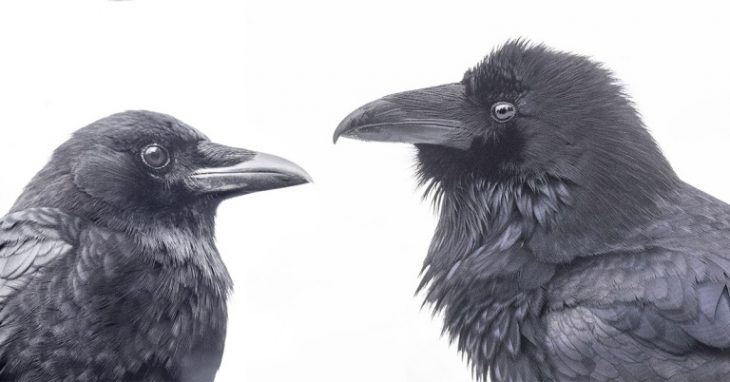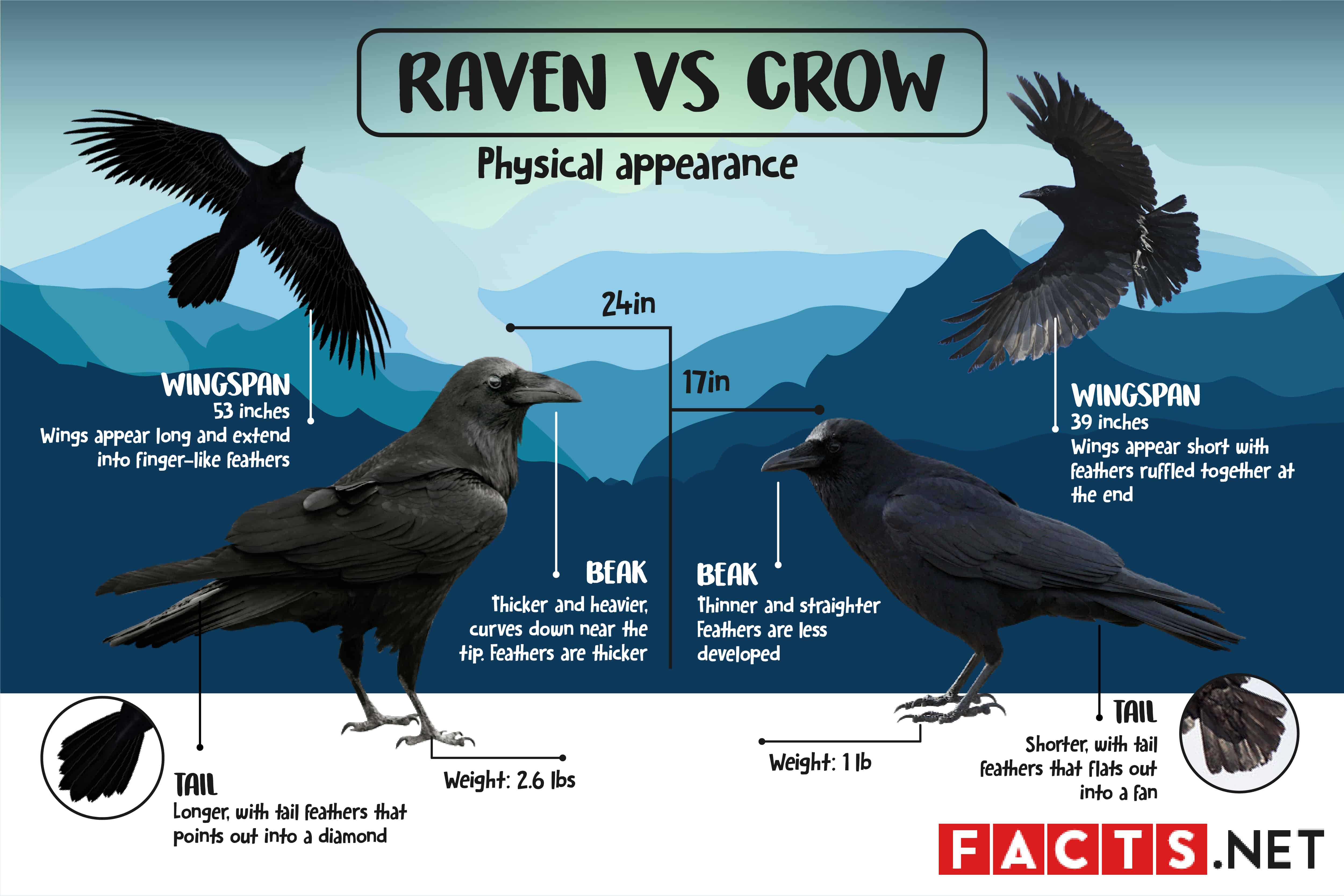в чем разница между crow и raven
Crow и raven разница
Ворон против Ворона
Вороны и вороны – это птицы, знакомые почти всем. Хотя обе эти птицы выглядят одинаково, между ними существует много различий: от физических особенностей до поведения и среды обитания.
Семья ворон охватывает различные виды птиц, таких как сороки, вороны и сойки. Из-за сходства внешнего вида многие неправильно используют названия птиц. Первое видимое различие между вороной и вороном – это размер. Вороны обычно больше по размеру, чем ворон. Когда ворон может достигать 64 см в высоту, высота ворона колеблется до 46 см. Аналогично, размеры крыльев, ног и клюва также различаются. Будучи крупнее по размеру, вороны намного тяжелее ворон. Возрастные периоды воронов больше, чем у ворон. Когда ворона живет до 8 лет, ворон может жить до 30 лет.
Перья Ворона блестящие и имеют фиолетовый оттенок, когда солнечные лучи падают на него. Но вороны имеют простые черные перья, которые также могут иметь более легкую маркировку. И, говоря о хвосте, хвост ворона имеет треугольную форму, а ворона – квадрат и даже. Вороны имеют более толстые клювы, чем вороны, которые помогают им в пищевых привычках. Другое отличие в клювах состоит в том, что ворона имеет своего рода плоский клюв, а ворон имеет изогнутый и мощный.
И если вы послушали крики обеих птиц, вы узнаете, что звук ворона более раздражает, чем ворон. У ворона есть возможность подражать некоторым звукам. Вы можете найти ворон в своем саду, соседних местах, электрических линиях и даже в суматошных местах. Но воронов нельзя найти так. Они любят одиночество и неприкосновенность частной жизни и, следовательно, находятся в лесах и холмах, где человеческое население меньше или равно нулю. Как и среда обитания, пищевые привычки воронов и ворон также различны. Когда вороны собирают фрукты, овощи и другие продукты в группах, вороны охотятся в одиночку. Таким образом, вороны никогда не являются друзьями фермера, поскольку он разрушает урожай. Хотя обе птицы всеядны и убираются на падаль, вороны больше питаются падалью, особенно овцами.
Во всем мире есть разные виды воронов, такие как американские воронки, воронки джунглей и вороны Карриона. Точно так же существует много разных разновидностей воронов.
Резюме: 1. Вороны и вороны отличаются размером, а вороны больше. 2. Вороны имеют фиолетовый блестящий оттенок на перьях, когда на них падают солнечные лучи, а воронки имеют простые темные перья. 3. Продолжительность жизни ворон намного меньше, чем у воронов. 4. Вороны убираются группами, а вороны охотятся в одиночестве. 5. Ворон можно найти среди жилищ людей, но вороны предпочитают держаться подальше в горах и лесах.
главное отличие между вороной и вороной в том, что ворона сравнительно маленькая, а ворон заметно больше, Кроме того, вороны живут группами, а вороны часто путешествуют парами. Кроме того, хвост вороны имеет форму веера, а хвост ворона имеет форму клина.
Ворон и ворон – две хорошо известные птицы черного цвета, встречающиеся по всему миру. Оба они принадлежат к родуCorvus и имеют мимолетное сходство друг с другом, что затрудняет их отождествление друг с другом.
Ключевые области покрыты
1. Ворона
– определение, характеристики, поведение
2. Ворон
– определение, характеристики, поведение
3. Каковы сходства между вороной и вороной
– Краткое описание общих черт
4. В чем разница между вороной и вороной
– Сравнение основных различий
Основные условия
Клюв, Черные невесты, Корвус, Ворона, Перья, Моббинг, Убийство, Ворон, Общительность, Хвост
Ворона – определение, характеристики, поведение
Ворона – птица черного цвета, принадлежащая к роду Corvus, Также в этот род входят ворон и грачи. Эти птицы хорошо известны своим умом, адаптивностью и громким резким звуком «кары». Кроме того, они принадлежат к семейству Corvidae наряду со сороками, сойками и щелкунчиками. Как правило, около 40 видов ворон встречаются по всему миру. Впрочем, американская ворона (Corvus brachyrhynchos) является наиболее распространенным видом вороны в Северной Америке. Вырастает до 17,5 дюймов в среднем до размера голубя.
Рисунок 1: Американская ворона (Corvus brachyrhynchos)
Обычно вороны живут большими группами и предпочитают жить на открытых площадках, включая луга и сельскохозяйственные угодья. Также группа ворон называется убийство, Когда одна ворона умерла, другие вороны собрались вокруг покойного, чтобы выяснить причину смерти, и объединились, чтобы преследовать хищника. Следовательно, такое поведение ворон известно как моббинг.
Ворон – определение, характеристики, поведение
Рисунок 2: Ворон (Corvus Corax)
Обычно вороны не являются социальными животными и живут в основном парами или в одиночку. Они предпочитают жить на открытых площадках и в лесах. По сравнению с воронами вороны ведут себя менее общительно.
Сходства между вороной и вороной
Разница между вороной и вороной
Определение
Ворона относится к большой птице, сидящей в основном с блестящим черным оперением, тяжелым клювом и хриплым голосом, а ворон относится к большой плотно сложенной вороне с в основном черным оперением, питающейся главным образом падалью. В этом основная разница между вороной и вороной.
Размер
Размер – главное отличие вороны от вороны. Размах крыльев вороны составляет около 36 дюймов, а размах крыльев ворона – около 42 дюймов. Кроме того, общая длина вороны составляет около 20 дюймов, в то время как общая длина ворона составляет 27 дюймов.
Первичные Перья
Более того, первичные перья вороны сравнительно малы, а первичные перья ворона длиннее. Таким образом, это одно видимое различие между вороной и вороной.
Хвост вороны мягко изогнут, как ручной веер, а хвост ворона заканчивается в точке, придавая ей форму ромба. Следовательно, это еще одно различие между вороной и вороной, которое помогает дифференцировать обеих птиц.
Перья под горлом
Еще одно различие между вороной и вороной заключается в том, что у ворон не хватает перьев под горлом, а у воронов мохнатые перья под горлом.
Форма клюва
Клюв также имеет значение между вороной и вороной. У Кроу прямой клюв, а у ворона изогнутый с волосами.
Щетина вокруг рта
Щетина вокруг рта – это еще одно различие между вороной и вороной. Щетинки вокруг рта вороны короче, а щетинки вокруг рта ворона длиннее.
вокализация
Основной образец вокализации вороны – это дребезжащий «каркающий» шум, в то время как ворон производит глубокий каркающий звук.
коммуникабельность
Другое различие между вороной и вороной состоит в том, что вороны живут большими стаями, а вороны живут парами.
Предпочтения Хабитат
Вороны предпочитают открытые площадки, а вороны предпочитают гулять в лесах.
интеллект
Американская ворона может распознавать лица, в то время как ворон имеет активное планирование и импульсивный контроль.
Срок жизни
Приблизительная продолжительность жизни вороны составляет 8 лет, тогда как приблизительная продолжительность жизни ворона составляет 30 лет. Это еще одно различие между вороной и вороной.
Заключение
Ворона – птица среднего размера черного цвета, принадлежащая к роду Corvus. Он живет группами на открытых пространствах и всеяден. Для сравнения, ворон – член большего размера того же рода. Живет парами, в основном внутри леса. И ворона, и ворон – очень умные формы животных. Поэтому основное различие между вороной и вороной – это стройность, анатомия и поведение.
Рекомендации:
1. Брэдфорд, Алина. «Факты о воронах». LiveScience, Закупка, 2 мая 2017 г.,
While crows and ravens may look similar and are both highly intelligent birds, they are very different in their behavior, habitat and even have physical characteristics that clearly distinguish them from one another.
Comparison chart

Contents: Crow vs Raven
Physical Appearance
Ravens are larger than crows. So they are longer, weigh more and have greater wingspan. When in flight their necks appear longer than that of a crow. The bill of a raven is also larger. Crows tend to fluff their feathers into a mane and when a raven fluffs up its breast it looks ragged.
The tails are also prominently different and this can be seen clearly when these birds are flying. Ravens have pointed wings and wedge-shaped tails but crows have blunt and splayed wings and fan-shaped tails.
Here’s a great video about the differences between ravens and crows and how to tell them apart:
Call of a Raven vs a Crow
Crows generally make the ‘Kaw’ sound in discrete units. A loud Kaw followed by a series of short Kaws. It is high pitched and nasal; crows are louder and have a harsher sound. A raven has deeper and less piercing sound. Their calls may sound like «croooaaak», «gronk- gronk», «tok», and «wonk-wonk.»
Listen to these audio recordings:
Intelligence
Crows are very intelligent and are known to devise ingenious ways of getting food and surviving in urbanized environments. In a study published in July 2014, researchers found that for certain cause-and-effect water displacement tasks (like The Crow and the Pitcher story in Aesop’s Fables), crows can perform as well as 7- to 10-year-old humans. In fact, crows can form special relationships with humans who feed them consistently. As an example, crows have been known to bring little trinkets as gifts for this family in Seattle.
Crows also have the ability to recognize and remember people by their faces. [1]
This video also demonstrates the intelligence of modern-day crows in Japan:
The Nature documentary The Murder of Crows (YouTube) is a great film for those interested in learning more about this extraordinary bird.
This video, shot in Canada, demonstrates the intelligence of ravens.
Tool Use
There are at least two known species of crows that use tools: the New Caledonian crow and the Hawaiian crow.
New Caledonian crows are even known to care for their tools and make new tools by bending straight pieces of garden wire into hooked foraging tools.
In a recent experiment, 93% of adult Hawaiian crows in captivity were able to find and use a stick to scrape meat out of logs with tiny holes. They had never done this before and it was a novel situation that they adapted to, using sticks as tools.
Ravens thrive on small invertebrates, amphibians, reptiles, small mammals, birds, cattle/sheep carrion, human garbage. Crows prefer birds, fruits, nuts, mollusks, earthworms, seeds, frogs, eggs, nestlings, mice and carrion.
Ravens and Crows in Mythology
Crows are associated with war and death in Irish mythology. In Cornish folklore crows are associated with the «otherworld» and so must be treated with respect. In Australian Aboriginal mythology, the crow is an ancestral being. In Buddhism the protector of the Dharma is represented by a crow in one of his physical/earthly forms.
The raven is revered as god by the indigenous peoples of the Pacific Northwest in North America and in northeast Asia. Several totem poles erected by native Americans in Washington, Alaska and Oregon depict ravens and the stories they feature in. In the Old Testament of the Bible there are several references to common Ravens. In the British Isles, ravens were symbolic to the Celts. In Irish mythology, the goddess Morrígan alighted on the hero Cú Chulainn’s shoulder in the form of a raven after his death.
References
Related Comparisons
Share this comparison:
If you read this far, you should follow us:
«Crow vs Raven.» Diffen.com. Diffen LLC, n.d. Web. 13 Jan 2020.
Comments: Crow vs Raven
Anonymous comments (1)
Ravens also spend a lot of time soaring like hawks. Crows will sometimes glide, but never soar.
Raven VS Crow
Published: 05 May 2021 17 Nov 2021
For most birdwatchers, distinguishing a raven from a crow is as easy as telling a peacock from a parrot. To most of us, however, it is easy to mix up the two black birds. At first glance, you’ll think that these birds are the same kind.
Common Ravens and American Crows are actually related. They come from the same family, Corvidae. The Common Raven’s scientific name is Corvus corax while the American Crow’s is Corvus brachyrhynchus. They have the same shape with the same black feathers. It doesn’t help that ravens and crows’ habitats overlap too as both populate North America in large numbers.
Despite these similarities, there are still distinct characteristics that can help us differentiate the two birds. Read on to find out how to tell a raven vs. a crow.
Raven vs. Crow: Physical Appearance
High in the sky, ravens and crows look the same. A black raven can easily be mistaken for a black crow. If we keep our eyes peeled, however, we’ll be able to tell the small yet sure differences between ravens and crows.
Ravens and crows have different sizes.
One principal difference between a raven and a crow is that one is larger than the other. The length of a Common Raven is usually 24 inches. An American Crow is around seven to eight inches smaller with a total length of roughly 17 inches.
Because of their different sizes, a raven naturally weighs heavier than a crow. A raven usually weighs up to 2.6 lbs while a crow is much lighter at 1 lb.

They have different beaks.
The beak of a raven is thicker and looks heavier than a crow’s. A raven’s beak curves down near the tip. Meanwhile, a crow’s beak is thinner and straighter. Feathers surround both of their beaks, but a raven’s feathers are much thicker and appear “shaggier.” The feathers surrounding a crow’s beard are less developed and look trim.

Their wingspans vary from one another.
A Common Raven’s wings can stretch out to as long as 53 inches. When we look at them in flight, we can easily see how the tips of their wings open into what look like long “fingers.” On the other hand, an American Crow’s wings are much smaller. From tip to tip, their wings usually measure 39 inches.
The next time you see a black bird in the sky, try paying closer attention to its wings. If its wings appear long and extend into individual finger-like feathers, then you’ve chanced upon a raven. If its wings seem short with feathers ruffled together at the end, then you’re looking at a crow.

Ravens and crows have different tails.
The shapes of their tails are also some of the easiest visual clues in determining a raven from a crow. A common raven’s tail is longer, with tail feathers that form a diamond or V-shape. This is because the tail feathers of a raven elongate in the middle, creating a pointy shape. In contrast, an American crow’s tail is shorter, with tail feathers that fan out in a curved shape during flight. In short, a common raven’s tail points out into a diamond while an American crow’s tail flats out into a fan.

Raven vs. Crow: Call sounds
People often ask, “Can ravens talk?” or “Can crows talk?” Well, the answer to that is that they call. This, too, is another way that we can tell a raven vs. a crow: a raven’s call sounds different from a crow’s call. So, if you’re trying to tell a raven from a crow, you’ll have to use your ears and listen closely.
A raven call is low-pitched while a crow call is high-pitched. To put it simply, crows caw while ravens croak. You’ll probably be more familiar with how crows call because most horror films use their “caw-caw” sounds as background music to set a scary scene’s mood. Still, a raven call is just as interesting and will help you determine one black bird from the other.
Raven vs. Crow: Diet
When it comes to food, ravens and crows are both omnivorous scavengers. This means that they eat both plants and animals. However, as scavengers, they mostly eat dead animals. While their classification is the same, their tastes still vary.
A raven mostly feeds on small animals, such as insects, mice, and lizards. A raven might also hunt smaller birds. You can also find ravens eating garbage in urban areas. Meanwhile, a crow will most likely feast on seeds, fruits, nuts, and worms. However, they too will take advantage of opportunities such as abandoned nests to steal eggs or young birds to eat.

Raven vs. Crow: Behavior
If you still find it difficult to tell a raven vs. a crow, then perhaps it might help to observe something else. Like humans, these black birds have distinct personalities too. If their physical appearance, call sounds, and diet don’t do the trick, why not try paying attention to how they behave?
Ravens and crows walk and fly differently.
What some people might not know about ravens and crows is that they have different manners of walking. The next time you find yourself in a park where black birds often fly over or idle by, pay close attention to their walk. If it walks like any other bird, then it’s an American Crow. If it walks and struts with two-footed hops, then you’ve found an American Raven.
This is a fun difference to watch out for that anyone can easily spot, so keep this in mind when you chance upon one of these black birds on the ground!
If the blackbird flies away before you can check their walk (or hop), then don’t worry. A raven flying is also different from a crow flying. In flight, ravens soar and glide through the air. You’ll hardly notice them flapping their wings. Meanwhile, crows frequently flap their wings while flying. This makes them look more energetic than ravens.
While they are both intelligent, their sociability differs.
What most people probably know about ravens and crows is how smart they are. Both ravens and crows have displayed clever problem-solving skills. This manifests in how they scavenge for food. When ravens and crows chance upon leftovers in sealed containers, they can open them after a few tries. To eat nuts they found, these black birds, especially crows, throw them on the ground to crack them open. Researchers have even observed some crows using small tools as well.
Ravens and crows are so smart that they can recognize human faces. This is probably why many people often ask, “Can I have a pet crow?” or “How can I befriend a crow?” It might be possible because of how American crows have excellent memories, but a word of warning: both ravens and crows are naturally distrustful of humans. American Crows might be more open to humans, but Common Ravens will most likely reject any attempts at friendship.
Of course, you shouldn’t take this personally. Even among themselves, Common Ravens often travel alone or just in pairs while American Crows flock into groups. They are much more sociable birds than Common Ravens. If you find a group of black birds huddled together, you are most likely observing crows.
Why do you think a group of crows is called a “murder of crows”? We all know that there is power in numbers, and these black birds think alike. American Crows are known to gang up on other predators. Sometimes, a murder of crows will mob a lonesome raven to ward them off from stealing eggs or baby birds from their nests. If you ever chance upon a black bird stand-off, then you can easily tell the crow from the raven by their numbers.
Raven vs. Crow: Habitat
The habitats of ravens and crows do overlap. They occupy North America in great numbers. However, there are some notable differences in the areas that they favor. Common Ravens are much more inclined to less populated areas. A raven’s habitat ranges from grasslands to beaches to forests to deserts. If you live in a rural area, where it is a lot less populated, then you’ll most likely catch a raven flying or perched on a tree every day. You can also find ravens in Central America, Europe, and Asia.

If you live in a crowded city or other urban areas, then you’ll most likely find a murder of crows instead. Crows are much more adaptable than ravens. They don’t shy away from populated areas. As long as there are trees around, then crows will have no problem surviving there. Crows, however, don’t favor deserts as much as ravens do. This is because deserts don’t have any trees for crows to nest on. American Crows will often avoid large, thick forests where daunting predators can attack them. You can easily find crows in some areas of Canada and throughout the United States.

Raven vs. Crow: Symbolism and mythology
A lot of people believe in superstitions about ravens and crows. A common belief is that they bring bad luck, just because of their midnight black color. This might also be because of how films often associate these black birds with witches and bad omens. However, when you ask someone, “What does it mean when you see a raven or crow?” not everyone will have the same answer. This is another difference between the raven and the crow that is tied to our social cultures.
Ravens appear in different mythologies.
In some Native American cultures, they view ravens as mischievous birds or tricksters. Some legends even portray a raven as a stealer of souls because of how they believe ravens act as messengers between the living and the dead. However, some tribes also revere the raven. In Washington, Alaska, and Oregon, you will even find totem poles that depict the Native American legends of these ravens.
In Norse mythology, believers associate the raven with Odin, the ruler of Asgard. As his messengers, two ravens named Huginn and Muninn fly around the world to collect intel and whisper it all into Odin’s ear. This is why Odin is called the “Raven God.” In many depictions, two ravens rest on Odin’s shoulders or his throne to emphasize the significance of these black birds’ roles in his legends.

Crows also star in their own share of legends.
In Irish mythology, crows symbolize war and death. This is like Indian Mythology, where the Indian epic, Mahabharata, associates crows as the messengers of death. They believe crows have the foresight and therefore often relay bad news to humans. In an Indian superstition, being visited by a crow at your home means an unwanted guest or visitor will arrive soon.
In contrast, Cornish folklore views the crow as an otherworldly or divine creature that warrants the utmost respect. This is like how Greek mythology reveres crows. Apollo, the Greek god of the Sun and archery, favors crows as his messengers. In one Greek tale, they say Apollo originally owned a white crow, one that he bid to watch over his lover, Coronis. However, while Apollo was away, Coronis fell in love with another, and the white crow reported this affair to Apollo. Overcome with rage and betrayal, Apollo struck a curse on the bird, turning its white feathers into a charred black.

At first, it might not be easy to tell a raven vs. a crow, but with these revealed differences, it can only get easier. Next time you’re in the park or out in the street and you notice a blackbird, watch, listen, and observe. That way, you’ll surely be able to provide plenty of answers to the question, “What’s the difference?”









